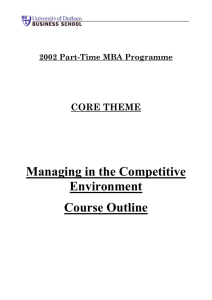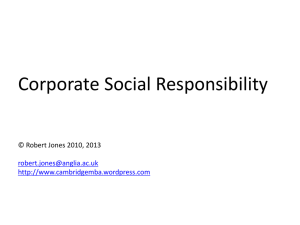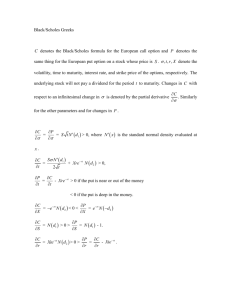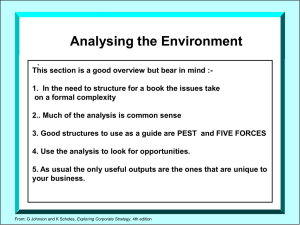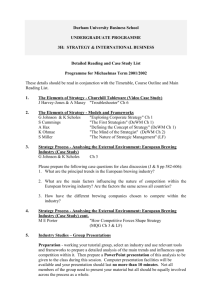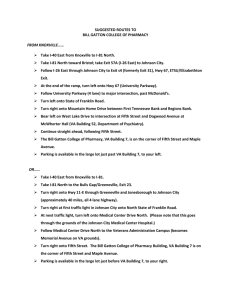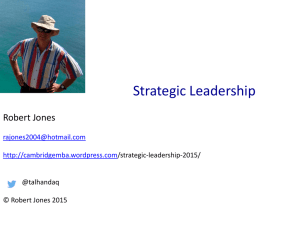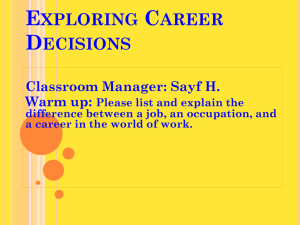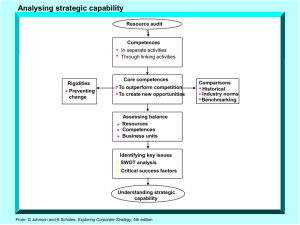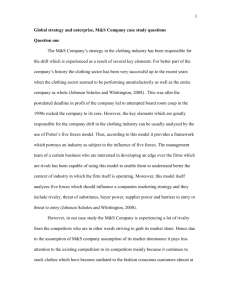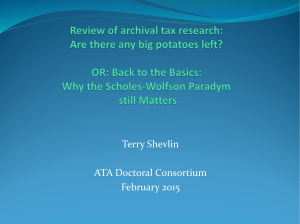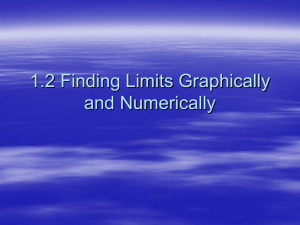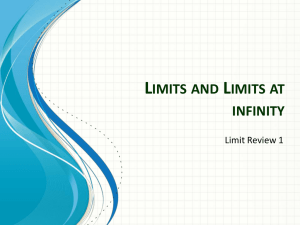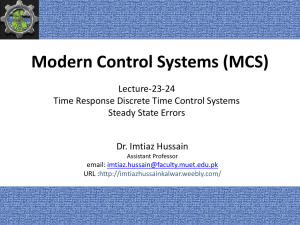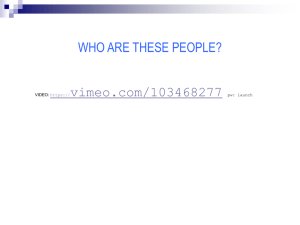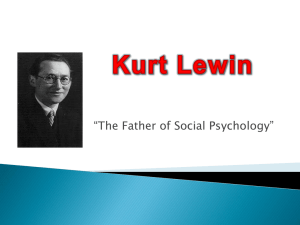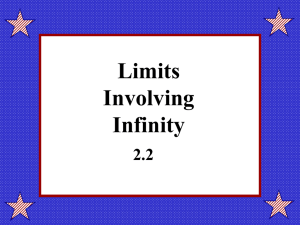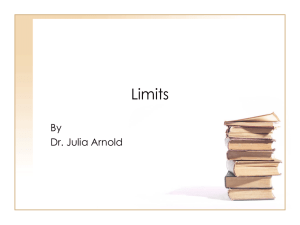Dr Michael Lim Change Management and Knowledge Management
advertisement
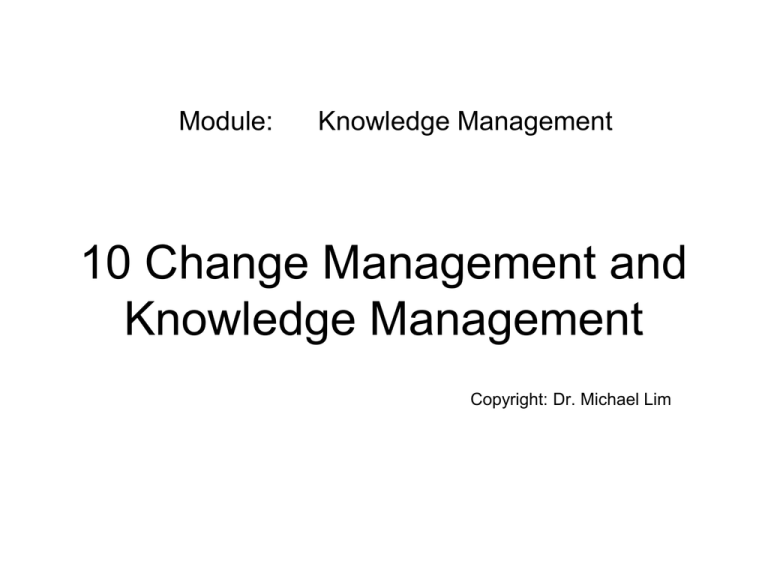
Module: Knowledge Management 10 Change Management and Knowledge Management Copyright: Dr. Michael Lim 5 Steps of Knowledge Management •1. •2. •3. •4. •5. Process Mapping Social Network Mapping Knowledge and Knowledge Process Mapping Strategy and Analysis Change Management Environment-Strategy-Structure-Operations (ESSO) Business Model (copyright: Dr. Michael Lim 2010) Environment PESTEL and Opportunities and Threats - How do they affect us and our Customers, Competitors & Suppliers Operations •Key activities •Key resources •Key competitors •Key suppliers and partners •Key customers- segment, channel (e.g. direct, franchise) •Cost and Revenue Operational Competitive priorities •Cost •Quality •Time •Flexibility •Innovation •Affective Strategy Market opportunities Competitive advantage Resource based view Market access e.g. government contracts Customer base– broad or narrow/ focused/ niche Knowledge Management •Knowledge in people’s heads •Documents, Databases and Resource Planning Programs •Strategy, Structure and Operations Structure •Hierarchy •Community (flat) •Mixed Design Copyright: Dr. Michael Lim (2010) Lim, M. 2010. Environment-Strategy-Structure-Operations (ESSO) Business Model. Knowledge Management Module at Bangor University, Wales. Available at: http://www.communitiesofinnovation.com/L/Dr_Michael_Lim_Business_Model_Knowledge_Creation_and_Innovation_Lecture_9.ppt (last accessed 02/12/10) Today’s Lecture • • • • • Why do organizations plan to change? Primary barrier to change Why are people resistant to change? Questions to ask before implementing change Lewin’s Theory of behaviour modification for change management • Styles and tactics for managing change • Learning Organization • Case Study: Wikipedia So… why should I stay awake? • Understand what prevents change in organizations • Understand how to implement change in organizations carefully • Understand how to plan for a learning organization that is capable of changing with the environment • Explore a social knowledge construction platform- Wikipedia • Understand the influence of motivation on change management- Wikipedia Why do organizations plan to change? • Respond to new Opportunities or Threats • Anticipation of the above Primary barrier to change •People Why are people resistant to change • • • • • Power- “Why must I listen to you?” Perception- “That’s the way to do it.” Habit- “I am used to doing it that way.” Inconvenience- “It’s troublesome to change.” Money- “Am I earning less? Will I lose my job?” • Security- “That’s the way it has always been done.” Adapted from Johnson, G., and K. Scholes. 1999. Exploring Corporate Strategy. Fifth edition. Prentice Hall Europe, London. Questions to ask before implementing Change • 1. Who does the change affect? • 2. Who will sustain the change? • 3. Is the change easy to understand and accept? Integrating Knowledge •1. Unfreeze Macroprocess – Probe and map – Heat •2. Integrate Macroprocess – Manipulate – Fit •3. Freeze Macroprocess – Monitor – Reinforce Adapted from Lewin, A. 1951. Field Theory in Social Science. Harper, New York. - Unfreezing, movement, refreezing Lewin’s Theory of Behaviour Modification for Change Management •1. Unfreezing – Probe and map the forces that maintain behaviour in its present form – Communicate need for change •2. Movement – Development of new attitudes or behaviour – Implement change •3. Refreezing – Stabilize change – Reinforce e.g. policies Adapted by Mullins, L. J. 2007. Management and Organizational Behaviour. Seventh Edition. Dorling Kindersley, Delhi. From Lewin, A. 1951. Field Theory in Social Science. Harper, New York. Forcefield analysis • Forces for change • Forces against change Johnson, G., and K. Scholes. 1999. Exploring Corporate Strategy. Fifth edition. Prentice Hall Europe, London. Styles of Managing Change • Direction • Education and Communication • Collaboration • Intervention •Coercion Johnson, G., and K. Scholes. 1999. Exploring Corporate Strategy. Fifth edition. Prentice Hall Europe, London. Change Tactics • Coherent change throughout the organization • Use of the appropriate change agents • Timing • Caring approach to job losses or those who suffer as a result of the change • Visible short-term wins Johnson, G., and K. Scholes. 1999. Exploring Corporate Strategy. Fifth edition. Prentice Hall Europe, London. Learning Organization • Traditionally, organizations are seen as hierarchies that maintain order and control, building stability and achieving efficiency (exploitation). • Now, the environment is fast changing, we need learning organizations that are fast at processing people’s collective knowledge and keeping in step with the customers’ changing demands (both exploitation and exploration). Johnson, G., and K. Scholes. 1999. Exploring Corporate Strategy. Fifth edition. Prentice Hall Europe, London. Four Premises of Learning Organizations • Organizational learning involves a tension between exploration and exploitation • Organizational learning is multi-level: individual, group, and organization • The three levels of organizational learning are linked by social and psychological processes: intuiting, interpreting, integrating, and institutionalizing (4I’s) • Cognition affects action (and vice versa) Crossan, M. M., H. W. Lane, R. E. White. 1999. An organizational learning framework: from intuition to institution. Academy Management Review 24 (3) 522-537. Crossan, M. M., H. W. Lane, R. E. White. 1999. An organizational learning framework: from intuition to institution. Academy Management Review 24 (3) 522-537. Case Study: Social construction of knowledge • Taking a look at Wikipedia • Issues – Quality – Power of incumbent volunteers • How to bring about change in an existing system that is being run by volunteers?
